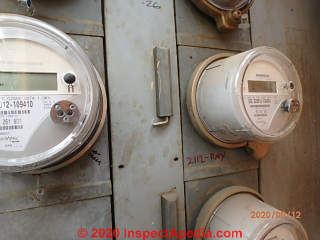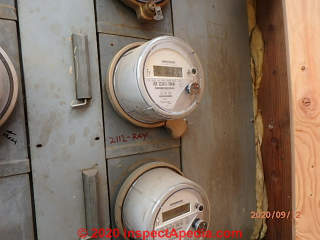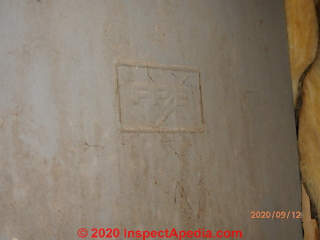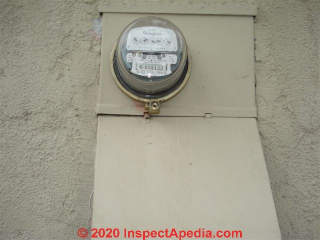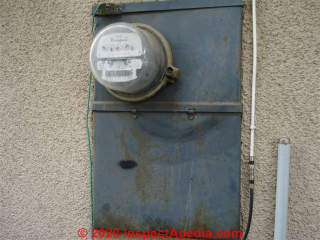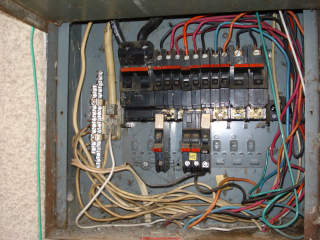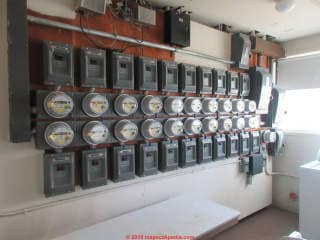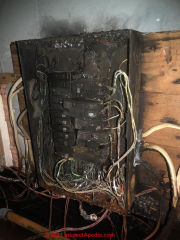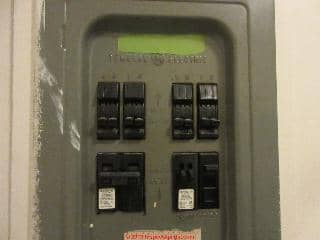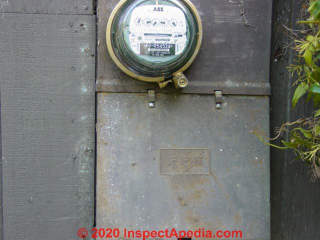 Federal Pacific Electric FPE Stab Lok Electric Meter Base & Main Switch
Federal Pacific Electric FPE Stab Lok Electric Meter Base & Main Switch
Identification & Hazards
- POST a QUESTION or COMMENT about FPE electric meter bases and main switch identification & hazxards
This document describes Federal Pacific Electric (FPE) or Federal Pioneer electric meter base equipment and main electrical switches often combined with the electric meter mount.
We provide identification photos and descriptions of FP or FPE or FE meter bases and main switches and we confirm that the FPE "no-trip" hazards exist at this equipment as it does in other FPE equipment.
Replacement FPE Stab-Lok® circuit breakers are unlikely to reduce the failure risk of this equipment. We recommend that residential FPE Stab-Lok® electrical panels be replaced entirely or the entire panel bus assembly be replaced, regardless of FPE model number or FPE year of manufacture. We do not sell circuit breakers nor any other products.
InspectAPedia tolerates no conflicts of interest. We have no relationship with advertisers, products, or services discussed at this website.
- Daniel Friedman, Publisher/Editor/Author - See WHO ARE WE?
Federal Pacific Electric Meter Covers, Main Switch FPE Meter Base
Question: were Stab-Lok Breakers used in FPE Electric Meter Base Mains?
Are you familiar with these FPE panels? In a condo complex. I was only there for one unit and the sub panel has been replaced with a newer Eaton panel. Do these multi meter FPE panels have the same hot bus bar configuration as a stabLok? - Tim Hemm
- Timothy Hemm, CREIA MCI, ASHI, ICC Certified Inspector, is a professional home inspector in Redlands, California and is a contributor to InspectApedia.com. Mr. Hemm can be contacted at (951)543-3501, timhemm@yahoo.com or tlhinspector@gmail.com , Website: www.homeinspectioninredlandsca.net
Moderator reply: FPE electric meter bases with main switch using FPE Stab-Lok breakers
There are some FPE meter bases that include one or more circuit breakers and those are indeed a stab Lok design. Your photos later on this page from 2016, are an easier-to-see example.
I couldn't see circuit breakers in your photos. If there are pull out fuses or if there are no circuit breakers, then that FPE issue would not pertain.
Reader follow-up:
The breaker is under that curved cover with the breaker handle connected to the piece of L shaped metal at the bottom. So pull down of the metal to turn off the power. No way to take it apart to see what kind of bus bar. So I will just use my canned FPE comment. I doubt the HOA is going to start replacing main panels. There is over 100 condos in this complex.
Moderator Reply - more examples of Federal Pacific Electric meter base with Stab-Lok breakers
If it's acircuit breaker in an FPE panel, it's an FPE Stab-Lok design.
FPE and FP never made any circuit breakers that were not of the Stab-Lok design.
The two photos below, provided to us by Pearson in 2003, show an electric meter base similar to that in your photos, as well as its attached FPE panel with FPE Stab-Lok circuit breakers.
Earlier fuse boxes by FPE don't have the "no-trip" safety concern.
More FPE Electric Meter Base Photos
Above and below a California FPE Electric Meter and main switch in commercial equpment, photos by Timothy Hemm (2016).
Below: examples of a residential FPE Electric Meter Base with Integrated Panel with Stab-Lok Breakers, courtesy of reader Portola (2010).
and another FPE electric meter and breakers at a second residential property:
Below: a bank of electric meters using Federal Pacific Stab-Lok boxes and main-breakers at each electric meter, courtesy of reader Vince ( 2018-11-13 ) discussed further
at FPE & FP IDENTIFICATION FAQs
In this photo the actual meter base may not be FPE-equipment.
Question: safety of FPE Meter Base & Main Switch equipment
[Click to enlarge any image]
2016/01/21 Steve Baker said:
I inspected one unit of a condo complex this week. The unit had a GE panel but the central bank of meters and main breakers were clearly labeled FPE and the 100 amp breakers were the typical FPE style.
The commercial article above does not exactly address meter banks. do you have any info about them? I do not feel qualified to recommend to the HOA that all the mains should be changed.
Reply: FPE Main Switch Double Pole Hazards - in panels and in separate FPE Electric Meter Base Panels
Steve:
OPINION:
I agree that it's not fun to bring bad news of hazards and expenses to the client. I've seen a range of responses from condos and apartments, from wholesale replacement of all of the FPE equipment to phased replacement, to a very unsafe approach of hiring an electrican to visually inspect or "test" the equipment and to declare it "safe" - a procedure that can actually increase the risk of a failure, fire or loss.
Because the "no trip" problem is the principal issue with FPE equipment (bus designs, breaker mounting and other issues are also present), and because the no-trip problem is innate in the internal design of the circuit breaker, it is absolutely present in the 100A mains you describe.
Worse, double pole breakers are more likely to jam internally after an overload on one side of the breaker, an event that can occur in a panel in which one of the sub-breakers on one side of the panel fails to trip.
The hazard is a latent one: the breakers don't initiate a problem, rather they fail to protect you when a problem occurs. So a panel may appear to be humming along "just fine" for decades, even if the breaker is not going to trip when it should - as it may not have seen an overcurrent.
The opinion of some electricians I worked with was that the main breaker was even more important than the individual circuit breakers.
Their reasoning was that if the Main is called-on to trip we are facing a very high current load and probably we already have a failure in the panel circuit breakers downstream.
You could argue that if the downstream GE breakers always do their job the risks at the FPE Main are reduced.
But there are some hidden risks: switching the breaker "OFF" may leave it "ON" internally, killing someone working on the electrical system who thinks they switched power off. Worse, switching breakers on and off to "exercise" them actually increases the risk of a no-trip or a Jam later.
Unfortunately we don't have a good analysis that quantifies the risk. My GUESS is that the risks are reduced by the GE sub panels but the risks are not eliminated.
At the very least I'd warn people that they may not have a safe, working, reliable main breaker - double pole FPE breakers may fail more than half the time - in an industry where the no-trip rate overall is probably less than 1% of the time. So replacement is a safe and advisable recommendation.
I suggest printing out Aronstein's FPE TEchnical report available in the ARTICLE INDEX to FPE STAB-LOK BREAKERS & PANELS live link given above. Give that to the Condo association management along with a warning; You are also welcome to print and give out copies of any of these web pages.
Here is a direct link to the latest Aronstein report:
FPE HAZARD REPORT - 2017 [PDF] independent research article by Jess Aronstein, supercedes older FPE hazard reports by this author.
inspectapedia.com/fpe/Hemm/FPEHemm04.jpg is an example photo of an FPE electric meter base and main switch, discussed at FPE Stab-Lok® PANEL COVERS
See more electric meter and meter base inspection points & details
at ELECTRIC METERS & METER BASES
...
Reader Comments, Questions & Answers About The Article Above
Below you will find questions and answers previously posted on this page at its page bottom reader comment box.
Reader Q&A - also see RECOMMENDED ARTICLES & FAQs
On 2021-04-09 - by (mod) -
@Dave, thank you for the helpful comment
On 2021-04-09 by Dave
@Javier, Yes that meter combo is FPE and needs to BE REPLACED ASAP ITS A FIRE HAZARD. It doesnt even have a main breaker it needs to go by by.
On 2021-04-09 by Dave
@Lisa, That burned up panel is a 100 amp main breaker SQUARE D QO PANEL that had ALUMINUM BUSS BARS IN IT. Aluminum is garbage
On 2019-12-24 by (mod) - Lisa's burned-up electrial panel looks like Square-D?
Our expert, Dr. Jess Aronstein comments that the breakers most resemble Square D Q-line but there is not enough detail to make a determination.
Lisa
I can't see enough of the bus bar into which the circuit breakers connect, but in your photo I do see the outer edge of a steel clip-bar that looks like it may NOT be an FPE panel. \
Typically the FPE breakers stab into an E-shaped or F-shaped connecting bus at their "live" end and have individual breaker clips that serve as an outer connector at the other end - we're taking a closer look.
On 2019-12-23 by Lisa
Is this a Federal Pacific panel? Any help appreciated.
On 2019-12-23 by Lisa
I am in need of finding out if this panel is A Federal Pacific? We had a fire in our rental home. Can’t find name on panel. Thanks in advance
On 2019-09-06 - by (mod) -
Apologies but I don't understand the question
But Watch out: if that's an FPE Meter base and Main Electrical panel - as it appears to be - it is a fire hazard and should be replaced.
On 2019-09-06 by Javier
Is a to old fP main panel I need to know if complete is?
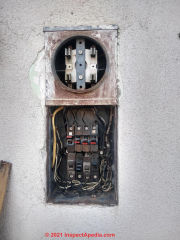
On 2016-11-09 - by (mod) -
Cathy:
The "amps" provided by an electrical panel is a feature of the size of the electric meter, wire to the panel, panel size, and panel main breaker. No one can steal any "amps" from an electrical panel. And adding-up the numbers on circuit breakers in the panel is NOT a measure of the amps provided by the panel.
However, if on opening the door to the electrical panel you see holes or openings where breakers are missing, or if some circuits in your home don't work, then yes something is wrong and you need help from a licensed electrician.
About panel location: for safety, an electrical panel must be able to be reached quickly and easily by a homeowner
. If the panel is in a crawl space it may not be safely located, and if the crawl space is bare, wet earth, even just touching the panel is dangerous, risking death by electrical shock. In such a case, moving the panel to a safe, approved, indoor location makes sense, and is not going to be "cheap" since all of its wires need to be extended to the new location.
About a panel going between your neighbor's panel and yours, that sounds unusual and indeed may be unsafe, improper, even a building code violation.
There are serious safety hazards when someone confuses panels in the way you describe, since in an emergency the occupants of a home may not know where to turn off power to a particular circuit.
For example, if your neighbour has "stolen" electrical power from you by wiring one of his or her circuits from your electrical panel, in an emergency someone might turn off the main breaker in the neighbor's panel and then be killed touching a circuit in the building that they though was "off" but in fact remained "on" as it was improperly wired from your panel.
As I said about your panel, also your neighbor's electrical panel absolutely must be immediately and readily accessible from his home. Otherwise the electrical system is unsafe and should be found not in compliance with yoru local electrical codes.\
Finally, ALL electrical work should be performed by a trained, licensed electrician.
On 2016-11-0 by Cathy
I have one other comment to follow about the amps, my circuit breaker trips frequently. Could my home pass inspection in 1980 in California if one home had 110 amps and the other 90? Something is fishy.
I live in a duplex or twin home. The two electric meters are on the exterior of the two homes and one building. The service panels are located underneath the building in a basement crawl space. My neighbor is an electrician. The building was built in 1980 and standard amperage then was 100 per panel.
My panel only has 90 amps, and my neighbor has 110 amps. My side was unoccupied for some time. I think my neighbor the electrician has stolen some of my amps.
How do I find out if he did this, there are no building plans or records available anymore. His panel interestingly is close to mine on my side underneath the building, and not on his side of the property.
There is one thicker wire that goes from his panel to mine. I disconnected it and my garage light no longer works. My insurance company told me he has to move his panel to his side. If this is done will I get my amps back if they were stolen? Any thoughts on this? Will it cost him a great deal of money to move his panel?
Even if he stole my amps, I don't want to be a jerk, but I am not insured if his panel is on my side, and there is a chain link fence under the property that I have to move to the middle and he will no longer be able to access his panel when this is corrected. I'm sure if he did steal some of my amps he did so without a permit.
Question: Electrician Report on FPE failures to trip
Being an electrician a few years now have ran into a few of these panels. They were common in trailers from the smaller 100amp mini trailer version to the industrial 40 space commercial which uses challenger style breakers. I've seen many times the breakers do not shut off entirely causing electrocution risk.
As a man of safety you always check for voltage even if the panel is well known QO ,homeline, ge, etc. I've seen I-line breakers on 480 not kill a pole causing an electrocution risk. Although very rare it does happen.
I can't stress enough to get the dangerous fpe's replaced. Once the breakers trip, they do not shut off or trip again due to arching welding the trip mechanism. I've seen outlets burned clean out of the wall causing fires many times. They had a huge run of these failed products here in the late 60's and 70's.
Also, do not think buying an aftermarket fpe replacement is going to magically fix the problem as the whole design was flawed.
These panels buss system uses the stab-lok interface which doesn't make good enough contact(although used copper buss) and causes deterioration of the insulator board behind the buss making a serious arch condition to the panels enclosure.
I've been called out after the utility co pulled the electrial meter out of an FPE firework show and the main never tripped. - Eric 1/26/2012
Reply:
Thank you Eric for this field report on FPE - I invite you to also report your experience to the US CPSC.
See ELECTRICAL PANEL / BREAKER INCIDENTS, HOW TO REPORT
On 2018-11-13 by (mod) - A GE Panel is NOT an FPE Stab-Lok panel
In your first photo I see FPE main breaker boxes below each electric meter - a critical safety hazard.
In your photos I see the individual panel is labelled General Electric - this is NOT an FPE Stab-Lok electrical panel. However the panel in your photo sports about a dozen individual switches or circuit breaker toggles. This exceeds the recommended "rule of 6" - IF the main breaker is not readily-accessible to the individual condo occupants or owners then a local main switch would be recommended.
Separately, among FPE circuit breakers, it is the two -pole 240V breakers that are among the worst performers, jamming in response to an overcurrent and then failing to trip at any amount of overcurrent whatsoever.
An additional issue is that the breakers may remain ON internally even when switched off at the toggle switch.
In my opinion those are very unsafe conditions justifying replacement of the electrical panels and breakers with a newer, more-reliable brand.
The actual failure rates for a variety of circuit panels and brands can be found in this article series
the series is given in the ARTICLE INDEX
I refer you to CIRCUIT BREAKER FAILURE RATES
It's probably the case that the main circuit breaker in a panel or for a panel is called-on to trip less-often than individual circuit breakers for the individual circuits in the building. However more than one electrician has commented to me that it's even more catastrophic when the main doesn't trip.
See details at FPE ELECTRIC METER BASE & BREAKERS
On 2018-11-13 by Vince
I am performing a multi-family PCA report for Fannie Mae. The individual unit breakers have all been replaced, however the electric meter center still includes Federal Pacific main service.
Is this still a known problematic building material, or is there no issue because the individual panels have been replaced? Attached picture of service center.
And here is a picture of the indivi dual breakers in the units.
2010/02/02 Sunrise FL, FPE breakers fail to trip during short circuit, reported 02/02/2010
This report is excerpted from
FPE FAILURE FIELD REPORTS
I was hoping you could shed some light on a frustrating problem regarding FPE breakers. Last week I created a short circuit thru a 120v kiln I was repairing in my garage. There was a loud pop and a brilliant flash. I immediately unplugged the kiln.
NONE OF THE FPE BREAKERS HAD TRIPPED, yet there was no power at that receptacle. I then discovered that all the 240v circuits and 2/3 of the 120v circuits in my home had no power. Only five 20 amp circuits were fine.
My electrician found an insufficient power reading before my meter. Then Florida Power and Light (FPL) diagnosed I had lost a power leg outside my home. They installed a power temp to step up my power from 120 to 240 volts. Next week their subcontractor will pinpoint the damage and dig it up. The temporary fix is working perfectly for now. FPL technicians said my short circuit could not have traveled that far thru defective breakers and damaged the FPL power feed outside my home.
BUT IT ALL HAPPENED AT THE VERY EXACT SAME MOMENT. I didn't want to press the point to FPL because of potential liability. Maybe when the subcontractors investigate, it will become apparent if the damage is aging infrastructure or something more.
The FPL technicians were not aware of FPE breaker problems. My electrician brought the FPE problems to my attention. He pointed out a very tiny burn mark on the meter. However FPL thinks the meter is fine and did not change it.
My electrician recommends replacing both the inside panel and also the outside main 150volt panel. We will be selling our house this spring and it could be a major issue. I would greatly appreciate your insight into this problem.
Actually this is the second time that I short-circuited my test kiln. The on-off switch burns out every 1-2 years. The kiln is 20 years old. I have replaced the switch a dozen times. So last month I replaced the switch as usual. But one protruding terminal touched the armature.
I turned on the kiln and flash-boom sparks were flying. No breakers were tripped.
But there was no power at that outlet. I must have stood there less than a minute and rechecked the outlet. Power was back at the outlet! Did it really go out? Maybe the light bulb I checked the outlet with was loose. It is possible that other circuits may have also been out during those seconds. The whole thing was like a surreal dream. I didn't investigate any further.
The kiln just sat there for a month, before I worked on it again. This time the switch terminal seems to have touched the element terminal. The control box is very cramped, and screws on to front of the kiln. Visibility is limited. I am not an idiot but I feel like one! I turn the kiln on and flash-boom. The rest you know.
So the 20 and 150 amp breakers actually failed twice. Power was lost twice. The first time power came back in a minute. The second time FPL tells me their line is damaged.
My electrician has quoted me $1050 to change both the outside 150amp main panel and the inside panel (cat. no L120-40). Seems to good to be true, unless the outside panel is a real easy job. He was recommended by my very knowledgeable realtor. He may have been motivated towards the low price by his two initial misdiagnoses which I never mentioned to you. At first he thought the 150amp breaker was damaged. He found a refurbished 150amp FPE but this did not fix the problem, and he removed it.
Then he decided the meter was damaged (it still might be proven so). At this point he said to call FPL to replace the meter. But another mystery at this point.....10 more single pole circuits came on by magic, but no double pole circuits!
The electrician couldn't explain it.! He said perhaps moving the meter affected it. But these 10 circuits went out about 15 minutes after the electrician left. This is just bizarre! Maybe the outside line fluctuated. Later FPL arrived and said the meter was fine, and installed the power temp until the line can be examined.
-- A.J.
2008 Louisiana FPE Stab-Lok® field failure report 11/19/2008:
I just ran accross your website and inspector information. I am a resident of Louisiana. Yesterday, I noticed a burning smell in my utility room where my Breaker panel was.
After further inspection, I've found burnt up wire from main line coming from electrical meter. I came to find replacement panel and noticed your website. I have a Federal Pacific Electric Company breaker panel Catalog No. L120-40. I noticed there was some settlements in New Jersey for this specific panel. What is being done for the rest of the country?
This box could of killed me and my family had I not found it at the specific time. Now I need to have a total replacement as per your recommendation. My home was built in 1981 but I am not the original home builder. Is there anything that Federal Pacific or its parent company has done to remedy this situation outside of New Jersey? Brock A. DeRouen
2003/05 California FPE Failure Report by Los Angeles Electrical Contractor -
I am an electrical Contractor in California, and I recently ran across
the Federal Pacific Electrical Panel with older "1970's" Stab-Lok® breakers. Here is the story.
The homeowner complained that a 220V circuit in the Play Room (separate
from the main house) was inoperative.
When I investigated, I found the
two wires laying in the service panel with no Circuit Breaker to
attached them to. Someone had previously removed them.
So, I tried to buy two 20 AMP Stab-Lok® breakers at the local Home Depot
suitable for the new Air Con, but they do not carry them.
I then did a
search on the internet and found your site
https://InspectAPedia.com/fpe/FPE_Fires_Waiting_to_Happen.php, and
https://InspectAPedia.com/fpe/FPE_Stab_Lok_Hazards.php which alerted me to a
possible problem and I informed the homeowner to that affect.
I asked the homeowner to call the Los Angeles Department of Water and
Power to have the Lock Ring removed so I could remove the Meter to
upgrade the Panel.
However, when the homeowner called the Local Department of Water and
Power (DWP), and they sent out two guys to look at the situation.
They
removed the Lock Ring from the 100 Amp Service Meter, and then
proceeded, trying to assist the homeowner's complaint, they connected
the two circuit wires to a 40 amp Stab-Lok® circuit breaker which feeds
the subpanel into the main house.
In affect, each of the 40 amp breakers
(see note below) now has two wires attached. The homeowner was
delighted that the DWP solved the problem, and call to inform me that
the problem was solved.
I dropped what I was doing and went to inspect what the DWP had done. I
couldn't believe it. The homeowner was adamant that I was incompetent
or just trying to rip them off. I had originally told them that the job
would cost around $120.00 to correct.
The potential for failure is now
greatly increased on this 40 Amp circuit, with circuit breakers that are
prone to failure. If the house burns down, the DWP will be liable.
Note: the Main House can draw as much as 60 amps during normal use, and
the New Air Con is rated at 12 Amps.
Tomorrow I will try to remedy this situation, but it won't be easy. Gerald C.P. - Electrical Contractor, to DJF - 05/03, photos provided.
1999/07/18 New Jersey FPE breaker failure electrician
- I am a lisc electrical contractor in new jersey and i have a
customer who has a 24 unit bldg with a seperate meter for each unit contain a 100 amp federal 2-pole main brkr in the
meter enclosure. recently there was a short or overload in one of the feeders and the 100 brkr didnt trip and caused some
minor damage to the enclosure .
The tenants want me to estimate the cost of remedying this problem .I would say replace
the enclosures but that would cost around $10,000 and the tenant board would not do it so i would like to find 100 amp
replacement brkrs ,do you know if the rep[lacements are as bad as the older 2 pole fpe brkrs ? do they make a modern
replacements with modern mechanics ?
The way i look at it is one brkr already proved it would fail and the rest were
likely from the same batch and i would hate to see them not front the cost and put themselves in a firerisk situation ,I
would like some more documentation on this preferably on the 2 pole 100 amps from the 1970's i have a copy i printed of
your article on the debate it was very helpful. Jim E to DJF - July 18, 1999
1998/02/03 FPE no trip at 650A, failure report,
drilled into feeder - I read with interst your articles on FPE Breakers. Back in late 1981
or early
1982 I accidentally drilled into my range feeder.
Although I had
recently exercised my breakers, and in spite of the fact that I
vaporized the tip of an Irwin Speedbor drill bit, and about 3/8 inch of
one side of a No. 6 service entrance cable, neither the feeder nor the
150 amp main tripped.
I think the breakers were probably made in 1969.
I have 1500 amps of available fault current at my meter base, and
calculated the level at the point of the fault to be around 650 amps.
I called the local FPE rep and asked for copies of the trip curves for the breakers.
They refused to supply them. I would be interested in any other information you might have come across since your article. Bob M to DJF - 2/3/98
1996/01/20 FPE Failure report - random cutouts - An anecdote. A couple of years ago I had a circuit that would cut out randomly. Sometimes it would stay on for only 10
minutes, sometimes for 2 weeks. I personally pulled every outlet looking for a cause.
Finally I gave up and called an electrician.
He went straight to the circuit breaker box,
pulled the face plate, and while he was telling me the hazzards of FPE, the breaker arced.
He proceeded to remove the breaker, which then crumbled in his hand. He had to scrounge to find a replacement.
This year I got the whole 20-year old FPE box replaced. In replacing the box, the electrician also replaced
the feed line that goes from the meter to the breaker box; the wire was perhaps under-rated for the add-ons that had been done to this house.
But he discovered something else interesting.
The neutral for the old line was half the size (or words to that
effect) of the hot wires. Switching to a full sized neutral has alledgedly fixed another problem:
when using an iron or certain other moderately high-amp items, lights throughout the house used to dim (especially those on dimmers). Rick J to DJF - 1/20/96
...
...
Continue reading at ELECTRIC METERS & METER BASES or select a topic from the closely-related articles below, or see the complete ARTICLE INDEX.
Or see these
Recommended Articles
- ELECTRIC METER & SEC SAFETY - Watch out -
- ELECTRIC METER ARC BURN POWER LOSS
- ELECTRIC METER OVERHEAT AL to CU WIRING
- ELECTRIC METERS & METER BASES - home
- FEDERAL PACIFIC FPE HAZARDS - home
- FPE FAILURE FIELD REPORTS
- FPE & FP IDENTIFICATION, HOW TO
Suggested citation for this web page
FPE ELECTRIC METER BASE & BREAKERS at InspectApedia.com - online encyclopedia of building & environmental inspection, testing, diagnosis, repair, & problem prevention advice.
Or see this
INDEX to RELATED ARTICLES: ARTICLE INDEX to FPE STAB-LOK BREAKERS & PANELS
Or use the SEARCH BOX found below to Ask a Question or Search InspectApedia
Ask a Question or Search InspectApedia
Questions & answers or comments about the markings and labels on FPE Stab-Lok® electrical panel covers, translation of FPE Electric Panel catalog numbers - does the label, year, or catalog number make a difference in the safety of the equipment?.
Try the search box just below, or if you prefer, post a question or comment in the Comments box below and we will respond promptly.
Search the InspectApedia website
Note: appearance of your Comment below may be delayed: if your comment contains an image, photograph, web link, or text that looks to the software as if it might be a web link, your posting will appear after it has been approved by a moderator. Apologies for the delay.
Only one image can be added per comment but you can post as many comments, and therefore images, as you like.
You will not receive a notification when a response to your question has been posted.
Please bookmark this page to make it easy for you to check back for our response.
IF above you see "Comment Form is loading comments..." then COMMENT BOX - countable.ca / bawkbox.com IS NOT WORKING.
In any case you are welcome to send an email directly to us at InspectApedia.com at editor@inspectApedia.com
We'll reply to you directly. Please help us help you by noting, in your email, the URL of the InspectApedia page where you wanted to comment.
Citations & References
In addition to any citations in the article above, a full list is available on request.
- Timothy Hemm, Yucala, CA, contributed the photographs of FPE equipment installed in California buildings. Mr. Hemm can be contacted at TimHemm@yahoo.com
- Arlene Puentes, an ASHI home inspector in Kingston, NY, contributed the page top and example photograph of a bank of FPE adjacent electrical panels. Ms. Puentes can be contacted at ap@octoberhome.com
- Jon Bolton, a home inspector, the Inspectigator, FL, contributed the "camouflage" breaker. Mr. Bolton can be contacted at teamattitude@hotmail.com
- Mary DeMuth, a property owner, contributed the Texas Federal Pacific Electric Load Center photos, May 2006.
- Thomas M. Pino, a professional home inspector, contributed photos of the 100A Texas FPE panel used in a condo. www.sweetwaterhomeinspection.com. Mr. Pino can be contacted at sweetinspect@houston.rr.com or at sweetwaterhomeinspection@yahoo.com
- L McIntire contributed photos of an FPE Stab-Lok® 200A Catalog No. C124-40N1, August 2009
- The remaining photographs on this page were made by the web author
- 2007 FPE Stab-Lok® TECHNICAL REPORT - an updated test report of independent testing (a large 1.2MB PDF file) using a larger pool of FPE Stab-Lok® circuit breakers than the older CPSC and Wright Malta tests found significantly higher failure rates of FPE Stab-Lok® circuit breakers, including a look at critical safety failures (breaker failed to trip at 200% of rated current or jammed) which found up to 80% failure rate for FPE Stab-Lok® GFCI circuit breakers (n=4), 12% failure rate for double pole FPE Stab-Lok® circuit breakers (n=120), and a 1% failure rate for FPE Stab-Lok® single pole circuit breakers (n=345).
- In addition to citations & references found in this article, see the research citations given at the end of the related articles found at our suggested
CONTINUE READING or RECOMMENDED ARTICLES.
- Carson, Dunlop & Associates Ltd., 120 Carlton Street Suite 407, Toronto ON M5A 4K2. Tel: (416) 964-9415 1-800-268-7070 Email: info@carsondunlop.com. Alan Carson is a past president of ASHI, the American Society of Home Inspectors.
Thanks to Alan Carson and Bob Dunlop, for permission for InspectAPedia to use text excerpts from The HOME REFERENCE BOOK - the Encyclopedia of Homes and to use illustrations from The ILLUSTRATED HOME .
Carson Dunlop Associates provides extensive home inspection education and report writing material. In gratitude we provide links to tsome Carson Dunlop Associates products and services.


